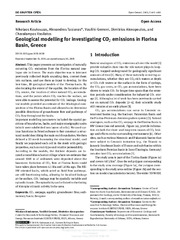Geological modelling for investigating CO2 emissions in Florina Basin, Greece
Permanent lenke
https://hdl.handle.net/10037/8685Dato
2015-10-15Type
Journal articleTidsskriftartikkel
Peer reviewed
Sammendrag
This paper presents an investigation of naturally
occurring CO2 emissions from the Florina natural analogue
site in Greece. The main objective was to interpret
previously collected depth sounding data, convert them
into surfaces, and use them as input to develop, for the
rst time, 3D geological models of the Florina basin. By
also locating the extent of the aquifer, the location of the
CO2 source, the location of other natural CO2 accumulations,
and the points where CO2 reaches the surface, we
were able to assess the potential for CO2 leakage. Geological
models provided an estimate of the lithological composition
of the Florina Basin and allowed us to determine
possible directions of groundwater ow and pathways of
CO2 ow throughout the basin.
Important modelling parameters included the spatial positions
of boundaries, faults, and major stratigraphic units
(which were subdivided into layers of cells). We used various
functions in Petrel software to rst construct a structural
model describing the main rock boundaries. We then
de ned a 3D mesh honouring the structural model, and
nally we populated each cell in the mesh with geologic
properties, such as rock type and relative permeability.
According to the models, the thickest deposits are located
around Mesochorion village where we estimate that
around 1000 m of sediments were deposited above the
basement. Initiation of CO2 ow at Florina Basin could
have taken place between 6.5 Ma and 1.8 Ma ago. The NESW
oriented faults, which acted as uid ow pathways,
are still functioning today, allowing for localised leakage
at the surface. CO2 leakage may be spatially variable and
episodic in rate. The episodicity can be linked to the timing
of Almopia volcanic activity in the area.
Beskrivelse
Published version also available at http://dx.doi.org/10.1515/geo-2015-0039


 English
English norsk
norsk